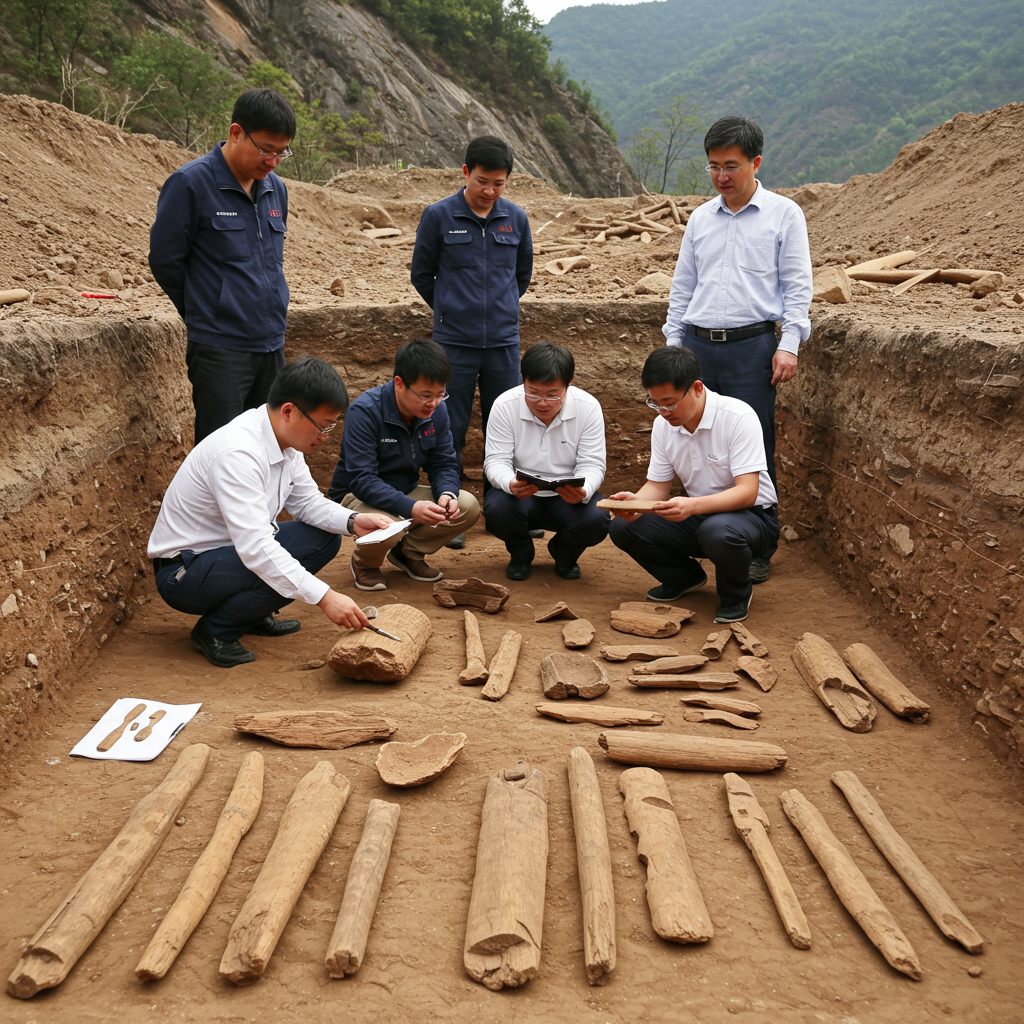Imagine holding an object crafted by human hands 300,000 years ago. A groundbreaking discovery in southwestern China has unearthed an extraordinary collection of ancient wooden tools, offering unprecedented insights into the lives, diet, and technological sophistication of early humans in East Asia. This find challenges long-held assumptions and paints a richer picture of our ancient ancestors.
Archaeologists working at the gantangqing site in Yunnan province, near Lake Fuxian, uncovered these exceptionally well-preserved artifacts. The collection comprises 35 distinct wooden tools. Their age, estimated at around 300,000 years old (falling within a range of 250,000 to 361,000 years based on multiple dating techniques), places them squarely in the Early Paleolithic period. This discovery is globally significant because finding wooden tools from such a deep past is incredibly rare.
The Extraordinary Discovery at Gantangqing
The sheer existence of these 300,000-year-old wooden tools is remarkable. Wood, unlike stone or bone, typically decomposes rapidly over time. Its survival for hundreds of millennia requires highly specific environmental conditions. The Gantangqing site provided just that.
Located on the edge of what was once a larger paleo-lake, the tools were preserved by being buried in oxygen-poor (anoxic) clay sediments. This waterlogged, oxygen-free environment prevented the bacteria and microbes that cause decay from thriving. Similar preservation circumstances have protected organic finds at other ancient sites around the world, including:
The famous Schöningen spears found in Germany
Ancient wooden structures unearthed in Zambia
A wooden plank discovered in Israel
Digging sticks found in Italy
The Gantangqing find, however, stands out as the first documented collection of Paleolithic wooden tools in East Asia, filling a critical gap in our understanding of prehistoric technology in this vast region. Researchers, including Jian-Hui Liu, Xing Gao, and Bo Li, meticulously selected the 35 tools from over a thousand pieces of preserved wood at the site, based on clear signs of deliberate shaping and use.
Unearthing the Purpose: Tools for a Plant-Based Diet
So, what were these ancient wooden tools used for? The evidence points strongly towards the exploitation of plants, particularly those found underground. Scientists conducted detailed use-wear analysis on the tools. This technique involves studying the microscopic damage and residues left on the tool edges from use.
Crucially, this analysis revealed the presence of starch grains on the tips of the shaped wooden sticks. Starch grains are direct evidence of processing starchy plants. This indicates that the hominins at Gantangqing were using these tools specifically for digging up nutrient-rich roots, tubers, or rhizomes from the lakeshore environment. This finding represents the earliest tangible evidence for the exploitation of rhizomes for food in Asia.
Further supporting a diverse diet, archaeologists at the site also found evidence of animal butchery, indicated by cut marks on deer and other animal bones. Plant remains like pine nuts, hazelnuts, kiwi fruit, and aquatic tubers were also recovered, painting a picture of early humans leveraging a variety of local food resources. Rare antler billets, likely used as soft hammers, were found alongside the wood and stone tools, highlighting a varied toolkit.
A Different Strategy: Asia vs. Europe
The primary function of the Gantangqing wooden tools—digging for plants—presents a fascinating contrast with some contemporary Paleolithic sites in Europe. For instance, the renowned wooden tools from Schöningen in Germany primarily consist of spears and throwing sticks, strongly suggesting a focus on hunting large mammals.
This difference in tool function suggests that early human groups developed diverse survival strategies tailored to their specific environments. While hominins in chillier, temperate Europe focused on hunting, those in the warm, wet, subtropical environment of prehistoric China likely benefited from abundant plant resources, leading to a dietary strategy that heavily involved foraging for roots and tubers using specialized wooden implements. This highlights the remarkable adaptability and resourcefulness of our ancient ancestors.
Beyond Stone: Sophistication of Early Asian Hominins
For a long time, archaeological understanding of early human technology has been heavily biased towards stone tools simply because they survive so well. This has sometimes led to the perception that hominin cultures in certain regions, including East Asia, were technologically less advanced or “conservative” compared to their counterparts in Africa or Western Eurasia, particularly during periods when complex stone tool techniques like Acheulean bifaces were less common in East Asia.
The sophisticated wooden tools from Gantangqing challenge this notion entirely. These artifacts show clear signs of deliberate and skillful crafting. Researchers observed evidence of:
Carving
Smoothing
Polishing
The level of craftsmanship demonstrated in shaping durable wood into effective tools underscores the advanced cognitive abilities and technological capabilities of the early humans living at Gantangqing. This discovery provides strong support for the idea of a widespread “Wood Age” during the Paleolithic, suggesting wood was a crucial material for toolmaking globally, not just an occasional substitute for stone.
Who Made These Ancient Tools?
While the scientific paper doesn’t definitively name the hominin species responsible for crafting these tools, it opens up intriguing possibilities. We know that different archaic human groups inhabited various parts of the world during this period. Denisovans, closely related cousins of Neanderthals and modern humans, are known to have been present in East Asia around this time.
The researchers speculate that Denisovans could be the toolmakers. This idea is partly supported by the size of some of the digging sticks, which the authors note might have been too large to be wielded easily by an average modern human hand. Based on the limited fossil evidence available, Denisovans appear to have been physically robust, potentially possessing the strength to comfortably use such tools. However, other smaller tools in the collection could have been used by human-sized hands, leaving the question open to debate.
The find also adds to growing evidence that sophisticated toolmaking from organic materials was not exclusive to Homo sapiens. Neanderthals, for example, are known to have made bone tools. Furthermore, recent discoveries, such as a 1.5-million-year-old bone tool industry found at Olduvai Gorge in Tanzania, demonstrate that organic tool use has deep roots in the history of our genus.
Craftsmanship and Variety
The collection of 35 wooden tools provides a glimpse into a versatile toolkit. The tools exhibit a range of forms and likely functions:
Digging Sticks: Varying in size, some were substantial, potentially requiring two hands, while others were smaller hand-held implements.
Pointed Tools: Smaller tools shaped with pointed ends for unknown specific tasks, perhaps related to plant processing.
Hook-Shaped Tools: Four unique pieces with a distinct hook morphology. While initially speculated they might be meat hooks (related to a theory about ancient smoked meat), use-wear analysis suggests they were more likely used for slicing through tough roots during excavation.
Analysis of the wood itself revealed that the tools were primarily fashioned from pine, though some were made from harder wood varieties. Unlike some other ancient wooden tools, like those found in Italy which show evidence of being heated before working (to make them easier to shape), the Gantangqing tools showed no signs of charring, despite charcoal being found in the same archaeological layers. This suggests a different method of wood working was employed here. The tools were clearly shaped at both ends – sharpened or rounded – and notably, most pieces retained no bark, indicating careful preparation. They were also found largely complete, unlike fragmented organic tools from other sites.
Significance and Future Insights
The discovery of these 300,000-year-old wooden tools at Gantangqing is a landmark moment in Paleolithic archaeology. It decisively demonstrates that early humans in East Asia possessed sophisticated woodcrafting skills, filling a significant void in the archaeological record. The direct evidence of intensive plant food exploitation, particularly rhizomes, provides crucial details about subsistence strategies that were potentially widespread in subtropical Asia, offering a valuable counterpoint to hunting-focused narratives from other regions.
This find underscores the critical importance of searching for and studying organic artifacts, not just stone, to truly understand the full technological repertoire and adaptive behaviors of archaic humans across different environments. It reinforces the view that cognitive sophistication and complex tool use were present among various hominin groups long before the advent of Homo sapiens*.
Frequently Asked Questions
How did these 300,000-year-old wooden tools survive?
Wood usually decays quickly, unlike stone. These tools survived for so long because they were preserved in unique environmental conditions at the Gantangqing site near Lake Fuxian in China. They were buried in oxygen-poor (anoxic) clay sediments near the ancient lakeside. This lack of oxygen prevented the bacteria and microorganisms that cause decomposition from breaking down the organic material over hundreds of thousands of years.
What did early humans use these ancient wooden tools for?
Use-wear analysis, which included identifying starch grains on the tool tips, shows they were primarily used for digging up underground plants like roots, tubers, and rhizomes. The collection includes digging sticks of various sizes and hook-shaped tools likely used for cutting roots during excavation. This is the oldest direct evidence found in Asia for such extensive plant-based food exploitation.
Why is finding these tools in China so important?
Finding well-preserved wooden tools from the Early Paleolithic (around 300,000 years ago) is incredibly rare globally. This discovery at Gantangqing provides the first documented collection of such ancient wooden tools in East Asia. It fills a major gap in the archaeological record, challenging previous assumptions that early Asian hominins were less technologically advanced or primarily stone-tool users, and demonstrating their sophisticated woodcraft and adaptable subsistence strategies focused on plant resources.
Conclusion
The extraordinary collection of 300,000-year-old wooden tools from Gantangqing, China, offers a profound new perspective on the capabilities and lifestyles of early humans in East Asia. By demonstrating sophisticated woodcraft, providing the earliest direct evidence of planned root foraging in the region, and highlighting diverse environmental adaptations, this discovery significantly enriches our understanding of human evolution during the Paleolithic. It serves as a powerful reminder that the full story of ancient human technology is yet to be uncovered, hidden not just in stone, but also in fragile organic materials preserved under exceptional circumstances.
Word Count Check: 1191




